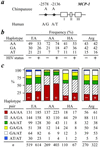HIV-1 infection and AIDS dementia are influenced by a mutant MCP-1 allele linked to increased monocyte infiltration of tissues and MCP-1 levels
- PMID: 12374865
- PMCID: PMC129777
- DOI: 10.1073/pnas.202357499
HIV-1 infection and AIDS dementia are influenced by a mutant MCP-1 allele linked to increased monocyte infiltration of tissues and MCP-1 levels
Abstract
Studies in humans and in experimental models of HIV-1 infection indicate an important role for monocyte chemoattractant protein-1 (MCP-1; also known as CC chemokine ligand 2), a potent chemoattractant and activator of mononuclear phagocytes (MP) in the pathogenesis of HIV-associated dementia (HAD). We determined the influence of genetic variation in MCP-1 on HIV-1 pathogenesis in large cohorts of HIV-1-infected adults and children. In adults, homozygosity for the MCP-1 -2578G allele was associated with a 50% reduction in the risk of acquiring HIV-1. However, once HIV-1 infection was established, this same MCP-1 genotype was associated with accelerated disease progression and a 4.5-fold increased risk of HAD. We examined the molecular and cellular basis for these genotype-phenotype associations and found that the mutant MCP-1 -2578G allele conferred greater transcriptional activity via differential DNA-protein interactions, enhanced protein production in vitro, increased serum MCP-1 levels, as well as MP infiltration into tissues. Thus, MCP-1 expression had a two-edged role in HIV-1 infection: it afforded partial protection from viral infection, but during infection, its proinflammatory properties and ability to up-regulate HIV-1 replication collectively may contribute to accelerated disease progression and increased risk of dementia. Our findings suggest that MCP-1 antagonists may be useful in HIV-1 infection, especially for HAD, and that HIV+ individuals possessing the MCP-1 -2578G allele may benefit from early initiation of antiretroviral drugs that effectively cross the blood-brain barrier. In a broader context, the MCP-1 -2578G allele may serve as a genetic determinant of outcome of other disease states in which MP-mediated tissue injury is central to disease pathogenesis.
Figures



Similar articles
-
The role of chemokine C-C motif ligand 2 genotype and cerebrospinal fluid chemokine C-C motif ligand 2 in neurocognition among HIV-infected patients.AIDS. 2015 Jul 31;29(12):1483-91. doi: 10.1097/QAD.0000000000000706. AIDS. 2015. PMID: 26244388 Free PMC article.
-
The monocyte chemotactic protein-1 -2578G allele is associated with elevated MCP-1 concentrations in cerebrospinal fluid.J Neuroimmunol. 2004 Dec;157(1-2):193-6. doi: 10.1016/j.jneuroim.2004.08.028. J Neuroimmunol. 2004. PMID: 15579297
-
Feasibility assessment of cerebrospinal fluid from HIV-1-infected children for HIV proviral DNA and monocyte chemoattractant protein 1 alleles.J Investig Med. 2006 Dec;54(8):468-72. doi: 10.2310/6650.2006.06007. J Investig Med. 2006. PMID: 17169271
-
Monocyte chemoattractant protein-1 (MCP-1): an overview.J Interferon Cytokine Res. 2009 Jun;29(6):313-26. doi: 10.1089/jir.2008.0027. J Interferon Cytokine Res. 2009. PMID: 19441883 Free PMC article. Review.
-
The role of monocytes and macrophages in the pathogenesis of HIV-1 infection.Curr Med Chem. 2002 Nov;9(21):1893-903. doi: 10.2174/0929867023368935. Curr Med Chem. 2002. PMID: 12369874 Review.
Cited by
-
Functional polymorphisms of the CCL2 and MBL genes cumulatively increase susceptibility to severe acute respiratory syndrome coronavirus infection.J Infect. 2015 Jul;71(1):101-9. doi: 10.1016/j.jinf.2015.03.006. Epub 2015 Mar 27. J Infect. 2015. PMID: 25818534 Free PMC article.
-
Genetic correlates influencing immunopathogenesis of HIV infection.Indian J Med Res. 2011 Dec;134(6):749-68. doi: 10.4103/0971-5916.92623. Indian J Med Res. 2011. PMID: 22310811 Free PMC article. Review.
-
Blood-brain barrier and retroviral infections.Virulence. 2012 Mar-Apr;3(2):222-9. doi: 10.4161/viru.19697. Epub 2012 Mar 1. Virulence. 2012. PMID: 22460635 Free PMC article. Review.
-
CCR2 mediates increases in glial activation caused by exposure to HIV-1 Tat and opiates.J Neuroimmunol. 2006 Sep;178(1-2):9-16. doi: 10.1016/j.jneuroim.2006.05.027. Epub 2006 Jul 10. J Neuroimmunol. 2006. PMID: 16831471 Free PMC article.
-
Sequence variation in the CC-chemokine ligand 2 promoter of pigtailed macaques is not associated with the incidence or severity of neuropathology in a simian immunodeficiency virus model of human immunodeficiency virus central nervous system disease.J Neurovirol. 2006 Dec;12(6):411-9. doi: 10.1080/13550280601009538. J Neurovirol. 2006. PMID: 17162657
References
Publication types
MeSH terms
Substances
Grants and funding
LinkOut - more resources
Full Text Sources
Medical
Molecular Biology Databases
Research Materials
Miscellaneous

